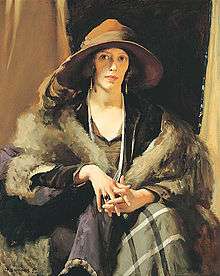William Beckwith McInnes

William Beckwith McInnes (18 May 1889 – 9 November 1939) was an Australian portrait painter, winner of the Archibald Prize seven times for his traditional style paintings.
Early life
McInnes was born in St Kilda, a suburb of Melbourne to Malcolm McInnes and his wife Alice Agnes, née Beckwith. Despite lack of family artistic tradition, he was keen to draw from the time he could hold a pencil. In 1903, at 14 years of age, he enrolled in the drawing school of the National Gallery of Victoria under Frederick McCubbin. Later he moved up to the painting school under Lindsay Bernard Hall.
Artistic career
He won the first prizes for drawing the figure from life, and for painting a head from life, and shared the prize for a landscape in 1908.
Soon afterwards McInnes held a successful show of his paintings at the Athenaeum Gallery in conjunction with F. R. Crozier, which was followed in 1911 by a journey to Europe, where he did much landscape painting and made acquaintance with the masterpieces of Rembrandt, Velasquez and Raeburn.
McInnes was represented in London at the exhibition of the Royal Institute of Painters in oils in 1913.
McInnes returned to Melbourne in the same year. A one-man show was held at the Athenaeum gallery and nearly everything was sold. In 1916 he acted as locum tenens for Frederick McCubbin, master of the school of drawing at the National Gallery of Victoria, Melbourne, during his six months' leave of absence, and after his death was temporarily appointed to the position in 1918. In 1920 he was permanently appointed.
In 1921, he won the first of his Archibald Prizes for portraiture.
McInnes revisited Europe in 1925 and on his return found he was in great demand as a portrait painter. For many years he was unable to spare time to do landscape work. In 1928 he exhibited with the Royal Academy, and in 1933 he visited England again to paint the Duke of York (later King George VI).
In the following year, on Bernard Hall leaving for England as adviser for the Felton bequest, McInnes was appointed acting-director of the National Gallery of Victoria, and on Mr Hall's death was appointed head of the painting school.
Amongst other portraits by McInnes were those of the surgeons Archibald Watson and Wood Jones.
Late life
McInnes had suffered from an imperfect heart all his life, his general health became affected and in July 1939 he resigned his position as master of the school of painting. He died on 9 November 1939. He married Violet Muriel Musgrave in 1915, a capable flower painter, who survived him with four sons and two daughters.
McInnes' artwork has been featured at the Art Gallery of South Australia. In addition, McInnes has painted a variety of important people in Australian history including officials and aristocratic families.
McInnes' Archibald Prize winners
- 1921 - Desbrowe Annear
- 1922 - Professor Harrison Moore
- 1923 - Portrait of a Lady
- 1924 - Portrait of Miss Collins
- 1926 - Silk and Lace
- 1930 - Drum-Major Harry McClelland
- 1936 - Dr. Julian Smith
McInnes also won the Wynne Prize in 1918 with The Grey Road.
References
- Haese, Richard. "McInnes, William Beckwith (1889 - 1939)". Australian Dictionary of Biography. MUP. Retrieved 2007-07-15.
Serle, Percival (1949). "McInnes, William Beckwith". Dictionary of Australian Biography. Sydney: Angus and Robertson.
External links
| Wikimedia Commons has media related to William Beckwith McInnes. |
| Awards and achievements | ||
|---|---|---|
| Preceded by new award |
Archibald Prize 1921 for Desbrowe Annear 1922 for Professor Harrison Moore 1923 for Portrait of a Lady 1924 for Portrait of Miss Collins |
Succeeded by John Longstaff |
| Preceded by John Longstaff |
Archibald Prize 1926 for Silk and Lace |
Succeeded by George Washington Lambert |
| Preceded by John Longstaff |
Archibald Prize 1930 for Drum-Major Harry McClelland |
Succeeded by John Longstaff |
| Preceded by John Longstaff |
Archibald Prize 1936 for Dr. Julian Smith |
Succeeded by Normand Baker |